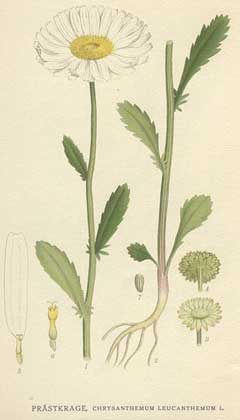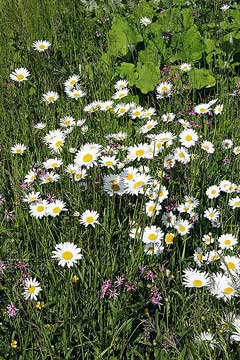 |
|
http://commons.wikimedia.org/wiki/File:Chrysanthemum_leucanthemum.jpg |
 |
| http://commons.wikimedia.org/wiki/User:Prazak |
Translate this page:
Summary
Bloom Color: White. Main Bloom Time: Early summer, Mid summer. Form: Upright or erect.
Physical Characteristics

 Leucanthemum vulgare is a PERENNIAL growing to 0.6 m (2ft) at a medium rate.
Leucanthemum vulgare is a PERENNIAL growing to 0.6 m (2ft) at a medium rate.
See above for USDA hardiness. It is hardy to UK zone 3 and is not frost tender. It is in flower from June to August. The species is hermaphrodite (has both male and female organs) and is pollinated by Bees, flies, beetles, Lepidoptera (Moths & Butterflies). The plant is self-fertile.
Suitable for: light (sandy), medium (loamy) and heavy (clay) soils and prefers well-drained soil. Suitable pH: neutral and basic (mildly alkaline) soils. It cannot grow in the shade. It prefers moist soil. The plant can tolerates strong winds but not maritime exposure.
UK Hardiness Map
US Hardiness Map
Synonyms
Chrysanthemum leucanthemum.
Plant Habitats
Meadow;
Edible Uses
Edible Parts: Leaves Root Shoots
Edible Uses:
Leaves - raw or cooked[2, 115]. The young spring shoots are finely chopped and added to salads[4, 7, 183]. Rather pungent[9], they should be used sparingly or mixed with other salad plants[183]. Root - raw[5]. Used in spring[207].
References More on Edible Uses
Medicinal Uses
Plants For A Future can not take any responsibility for any adverse effects from the use of plants. Always seek advice from a professional before using a plant medicinally.
Antispasmodic Antitussive Diaphoretic Diuretic Emmenagogue Tonic Vulnerary
The whole plant, and especially the flowers[7], is antispasmodic, antitussive, diaphoretic, diuretic, emmenagogue, tonic and vulnerary[4, 7, 21]. It is harvested in May and June then dried for later use[4]. The plant has been employed successfully in the treatment of whooping cough, asthma and nervous excitability[4]. Externally it is used as a lotion on bruises, wounds, ulcers and some cutaneous diseases[4, 7]. A decoction of the dried flowers and stems has been used as a wash for chapped hands[257]. A distilled water made from the flowers is an effective eye lotion in the treatment of conjunctivitis[7].
References More on Medicinal Uses
The Bookshop: Edible Plant Books
Our Latest books on Perennial Plants For Food Forests and Permaculture Gardens in paperback or digital formats.

Edible Tropical Plants
Food Forest Plants for Hotter Conditions: 250+ Plants For Tropical Food Forests & Permaculture Gardens.
More

Edible Temperate Plants
Plants for Your Food Forest: 500 Plants for Temperate Food Forests & Permaculture Gardens.
More

More Books
PFAF have eight books available in paperback and digital formats. Browse the shop for more information.
Shop Now
Other Uses
Groundcover and Specialist Nectary. Landscape Uses:Ground cover, Massing. Special Features:Invasive, Naturalizing, Attracts butterflies, Suitable for cut flowers.
Special Uses
Food Forest Ground Cover Scented Plants
References More on Other Uses
Cultivation details
Easily grown in a good garden soil in a sunny position[187]. Prefers a rich soil[17]. Plants are hardy to at least -20°c[187]. The whole plant is permeated with an acrid juice, making it obnoxious to insects[4]. The flowers have a smell like stale perspiration[245]. Grows well in the summer meadow but may need some help in maintaining itself[24]. In garden design, as well as the above-ground architecture of a plant, root structure considerations help in choosing plants that work together for their optimal soil requirements including nutrients and water. The root pattern is rhizomatous with underground stems sending roots and shoots along their length [2-1].
References Carbon Farming Information and Carbon Sequestration Information
Temperature Converter
Type a value in the Celsius field to convert the value to Fahrenheit:
Fahrenheit:
The PFAF Bookshop
Plants For A Future have a number of books available in paperback and digital form. Book titles include Edible Plants, Edible Perennials, Edible Trees,Edible Shrubs, Woodland Gardening, and Temperate Food Forest Plants. Our new book is Food Forest Plants For Hotter Conditions (Tropical and Sub-Tropical).
Shop Now
Plant Propagation
Seed - sow spring in a greenhouse. When they are large enough to handle, prick the seedlings out into individual pots and plant them out in the summer. Division in spring or autumn. Larger clumps can be replanted direct into their permanent positions, though it is best to pot up smaller clumps and grow them on in a cold frame until they are rooting well. Plant them out in the spring. Basal cuttings in spring. Harvest the shoots when they are about 10cm long with plenty of underground stem. Pot them up into individual pots and keep them in light shade in a cold frame or greenhouse until they are rooting well. Plant them out in the summer.
Other Names
If available other names are mentioned here
Native Range
TEMPERATE ASIA: Armenia EUROPE: United Kingdom, Ireland, Austria, Belgium, Switzerland, Czech Republic, Germany, Hungary, Poland, Slovakia, Russian Federation (European part), Belarus, Estonia, Lithuania, Latvia, Moldova, Ukraine (incl. Krym), Bosnia and Herzegovina, Greece, Croatia, Italy, North Macedonia, Montenegro, Serbia, Slovenia, France, Portugal
Weed Potential
Right plant wrong place. We are currently updating this section.
Please note that a plant may be invasive in one area but may not in your area so it's worth checking.
Conservation Status
IUCN Red List of Threatened Plants Status :

Growth: S = slow M = medium F = fast. Soil: L = light (sandy) M = medium H = heavy (clay). pH: A = acid N = neutral B = basic (alkaline). Shade: F = full shade S = semi-shade N = no shade. Moisture: D = dry M = Moist We = wet Wa = water.
Now available:
Food Forest Plants for Mediterranean Conditions
350+ Perennial Plants For Mediterranean and Drier Food Forests and Permaculture Gardens.
[Paperback and eBook]
This is the third in Plants For A Future's series of plant guides for food forests tailored to
specific climate zones. Following volumes on temperate and tropical ecosystems, this book focuses
on species suited to Mediterranean conditions—regions with hot, dry summers and cool, wet winters,
often facing the added challenge of climate change.
Read More
Expert comment
Author
Lam.
Botanical References
17200
Links / References
For a list of references used on this page please go here
Readers comment